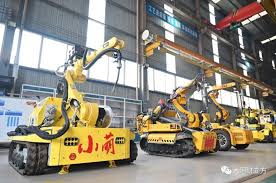A new era of Daokou Roast Chicken

Henan Daily
Zhengzhou: If your impression of Henan food still remains centered around its production of half of the nation’s sausages, one-third of instant noodles, and seven-tenths of dumplings… then it might be time to update that perception.
Paving new paths in the fields of leisure snacks and pet food; breaking the international monopoly on probiotics through independent innovation; supplying 70% of the specialized food for China Aerospace… This represents the present and future of the food industry in Henan.
The “7 + 28 + N” industrial chains in Henan are being constructed at an accelerated pace, with the modern food industry cluster being one of them. The 2024 Government Work Report of Henan Province points out that it will focus on four key industrial chains: leisure food, cold chain food, prepared dishes, and alcoholic beverages, and establish an integrated modern food industrial chain covering “production, purchase, storage, processing, and sales.”

During the growth and expansion of the modern food industry in Henan, thanks to its transportation location and resource advantages, a development pattern has emerged with the Beijing-Guangzhou Railway Line as the main axis, driving the development of the whole province and radiating across the country. Top Financial, in collaboration with the Henan Modern Food Industry Alliance and the Henan Food Industry Association, has conducted research and interviews in eight cities along the food industry belt of the Beijing-Guangzhou Railway Line in Henan, launching the series “Henan Food Towards A New Era” to showcase the development trend and new quality productivity of Henan food as it progresses from the “Chinese kitchen” to the “world’s dining table”.
New Industrial Model: Computer control replaces manual cooking, making the production process intelligent; suppliers become shareholders, integrating business operations; one chicken with one code, enabling traceable brand protection.
The signboard of “Famous Roast Chicken City of China” comes into view on the spacious North Ring Road upon entering the boundary of Huaxian, Anyang City. From this point on, the trip to Huaxian will be filled with the ubiquitous “roast chicken” signboards on the streets and alleys, and some people always joke that no chicken can fly out of Huaxian alive.
With a history of over 300 years, it is renowned as one of the four famous chickens in China. Only those produced in Huaxian, Anyang can be called “Daokou Roast Chicken”. Currently, the annual production capacity is 25 million, and the output value exceeds 1 billion yuan.
How can a roast chicken span time and space, carrying the charm of the past and passing on the ancient delicious flavor to this day? This is not only due to the exquisite traditional craftsmanship and inheritance but also to its continuous pursuit of innovation in intelligent production processes, integrated business models, and traceable brand protection.
New Technology: Intelligent Automation Replaces Manual Labor, Doubling Production Capacity
Daokou Roast Chicken is led by leading enterprises such as Yixing Zhang and Hua Baogang Roast Chicken Co.,Ltd.
Upon entering the visiting workshop of Daokou Hua baogang Roast Chicken Co., Ltd., one is immediately enveloped in a rich and fragrant aroma, which makes one’s mouth water.
Looking inside through the glass on the second floor, the rows of roast chickens hanging on the metal racks are arranged in an orderly manner, presenting a magnificent sight. On the same day, these roast chickens will appear on various dining tables, for warm family gatherings or a formal business banquets.
The roast chicken cooking process of the company has achieved an intelligent upgrade by building the new factories with an investment of 250 million yuan.
Previously, experienced chefs judged how long the heat should be set for and to what degree the chicken should be cooked to be considered fully cooked. Now, with computers, various parameters such as heat and time can be set. This not only saves labor but also enables standardized production of products.
It is said that on the entire production line, the vast majority of processes have been replaced by mechanization instead of traditional manual labor, improving efficiency and directly increasing the production capacity from 5 million to 15 million units, doubling the production capacity.
Driven by intelligent mechanized production methods and the influence of leading enterprises, the scale of the local roast chicken industry is further expanding.
It is said that more than 300 companies in Huaxian County sell 25 million roast chickens each year, with a production value exceeding 1 billion yuan and more than 2,000 franchise stores across the country.
New Model: Partners Become Shareholders, Deeply Coupling the Industrial Chain
People in Huaxian have a long-standing habit of raising chickens. In recent years, the scale, standardization, and industrialization level of the chicken-raising industry in the county have been rapidly improved. In 2023, the county’s chicken output reached over 41 million, but not all of the slaughtered chickens are suitable for processing into Daokou Roast Chicken.
Out of the 25 million roast chickens sold each year, only about 5 million are supplied by local farms, while around 80% come from surrounding counties and provinces.
The inability to fully self-supply raw material chickens is undoubtedly a major problem for the development of the industry. Therefore, the local government has decided to develop a complete industrial chain from the source of supply to solve the problem.
In recent years, relying on leading enterprises such as Hua Baogang and Zhang Cunyou Roast Chicken, Huaxian County has built an integrated industrial development pattern of “breeding base-slaughtering and processing-cooked food manufacturing-packaging logistics-product sales,” focusing on creating an ecological meat product industrial chain.
Meanwhile, bold innovations have also been made in the development model to ensure the reliability of product quality and the stability of supply.
Some enterprises have taken the lead in the shareholding reform and transformed breeding farms into shareholders of the company through equity swaps, achieving seamless connection and deep integration of the supply chain.
For example, when facing the challenge of low market prices for live chickens, roast chicken enterprises can fully utilize their slaughtering advantages in the factory to process live chickens supplied by farms into higher value-added products (ready-to-cook chickens), thereby effectively increasing market prices.
The deeply coupled model of upstream and downstream in the industrial chain undoubtedly injects a “boost” into the industry development.
New Label: One Chicken with One Code Traceability, Strengthening Brand Protection
The origin of Daokou Roast Chicken can be traced back over 300 years.
According to the records in theHuaxian Annals, it was founded in the eighteenth year of Shunzhi in the Qing Dynasty(1666 AD). Since the ancestor of the current roast chicken master Zhang Cunyou founded the “Yixing Zhang” brand, Daokou roast chicken has begun to spread. Up to now, in addition to the aforementioned Yixing Zhang and Hua BaoGang, there are also many other brands such as Zhongfa, Xuewang, Yuweixiang, and Ding Gewei.
Over time, merchants have become increasingly aware of the value of brands and of the need to protect those brands.
For example, Hua BaoGang produces about five thousand roast chickens daily, and each roast chicken has a unique anti-counterfeiting QR code attached to its leg. Without exception, scanning the code will reveal information such as the production date.
This iconic new label can be regarded as the “identity card” of each chicken, not only allowing consumers to easily trace the source and eat healthily but also serving as a powerful tool for brand protection.
Another incident regarding the trademark “Yixing Zhang” of Daokou Roast Chicken has become a hot topic.
In 2019, Zhang Cunyou, the eighth-generation descendant of “Yixing Zhang,” spent 8 million yuan to “redeem” the trademark, ending a 38-year separation between the trademark and the company name. Since then, the rights to use the “Yixing Zhang” trademark and the business name have been unified.
Undoubtedly, local enterprises spare no expense in protecting their brand assets, maintaining their reputation and image, laying a foundation for the long-term development of the enterprise and having a profound impact on the sustainable development of the industry.
Daokou Roast Chicken, together with “Dezhou Braised Chicken,” “Fuliji Roast Chicken,” and “Goubangzi Smoked Chicken,” are renowned as the “Four Famous Chickens” in China. However, it is not without flaws, and there are also shortcomings in its development.
For example, due to climatic conditions, the sales range of freshly roasted chicken is usually limited to a radius of 150 kilometers. Although soft-packaged roasted chicken that has undergone high-temperature sterilization extends its shelf life, its flavor and texture are greatly reduced. This has become a key bottleneck hindering the market expansion and international recognition of Daokou Roast Chicken.
To further address industrial shortcomings, tap the brand resources of Daokou roast chicken, and accelerate the development of the entire industrial chain of Daokou roast chicken, Huaxian County is going all out.
It is reported that the county has invested 1 billion yuan to launch the chicken source base construction plan, which includes the establishment of a special breeding base for 800,000 sets of Daokou roast chicken, a hatchery base for 110 million chicks, and a modern Daokou roast chicken industrial park covering an area of 370 mu (about 60.95 acres).
At the same time, Huaxian will select 2-3 leading enterprises with advanced concepts, strong capabilities, and good development potential from existing roast chicken processing companies and focus on nurturing them by providing policy support in multiple aspects such as land, technology, and funding.
Regarding the future development of the roast chicken industry, Huaxian has set a goal: by 2025, strive to cultivate more than one traditional advantageous food production area with an annual revenue exceeding 500 million yuan, more than three leading enterprises with an annual revenue exceeding 50 million yuan, and create well-known brands and typical cases of industrialization of Daokou roast chicken.





